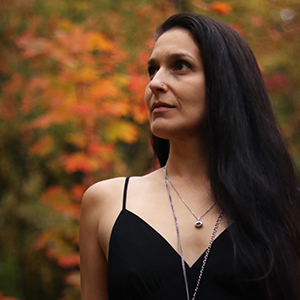The Fluidity of Healing: Délani Valin in Conversation with Meryem Yildiz

Poetry and Fiction Editorial Board member Délani Valin talks with Meryem Yildiz, winner of the 2022 Far Horizons Award for Poetry with her poem, “Inner Child Work” (featured in fall issue #220). They discuss objects as storytellers, themes of death and rebirth, and how the past and present are in constant dialogue.
Read her poem “Inner Child Work” here.
Meryem Yildiz is a poet, translator and visual artist born and based in Tiohtià:ke (Montreal). She has contributed to various multidisciplinary events, literary magazines, and other publications in Canada and abroad. She holds a BA in psychology from McGill University and a graduate diploma in translation from Concordia University. As a hybrid bird, she feels most at home in liminal spaces.
Congratulations on winning the Far Horizons Award for Poetry with your poem, “Inner Child Work”! Judge Laura Ritland remarked on the form of the poem, particularly all of the ways in which it “recalls and rewires the sonnet form.” Can you talk about why you chose the form, and how it relates to the poem’s subject matter?
Any one of us on a healing journey will hear, at some point or other, that progress is not linear. There aren’t measured, methodical steps leading us to one final, blessed state. It has peaks and valleys, and winding rivers. As we learn new ways of seeing, being, and feeling, we realize that they don’t always translate seamlessly into our hardened patterns. Healing takes time, patience, and practice. A traditional sonnet is known for its strict structure and intricate rhyming scheme. By deconstructing it and allowing it to shift in form, I echo healing’s fluidity. A variation on the sonnet provides a flexible vessel that is akin to the renewing self, as well as the complex and often tumultuous journey leading to it.
There are beautiful objects featured throughout the poem—a gold necklace, woven blankets from Denizli, an oil painting of the speaker’s mother. These objects feel like an inheritance, like heirlooms. Could you say a bit about why you included them?
Objects bear witness to the relationship between our minds and the world. The objects I chose are concrete elements that I can see with my eyes and feel with my hands, but they’re also symbols rich in history and significance. They’re storytellers, treasures of the psyche. In dream interpretation, home typically symbolizes the whole being, while rooms represent different aspects of the self. Likewise, these objects are part of an inner sanctum. They recall memories, are linked to “doing the work,” and are ultimately given new meaning and used as a catalyst toward mending wounded parts. Everyone has a collection of objects they love, sacred pieces that are special to them. These are some of mine.
Another motif in the poem is the lightbulb, at first broken and neglected, and then at the climax of the poem, the speaker changes the bulb and there’s an invitation to turn the light bulb on. How did you choose this as a metaphor for the poem?
I can’t say it was a conscious choice! I wrote the first draft and there it was, my own little lightbulb moment, and I loved how it could express so much, so simply, about the overarching themes of death and rebirth, beginnings and endings. Darkness is the foundation of inception, the land of preludes, where discoveries are brewing. In a lightless room—in a room of absence, tension, or loss—there’s still beauty and meaning, they’re just concealed, waiting to be revealed. How can we see them? How can we shine light on them? The lightbulb is associated with mental energy; it contains the hopes of transformation, becomes the source of growth and introspection, unveils the wholeness of being. It embodies a moment of clarity, sparking divine change that is so very welcomed.
Your biography mentions you have a BA in Psychology from McGill University. Has what you learned in this program influenced the writing of “Inner Child Work?” What about in your other writing?
I truly believe in everyone’s ability to grow. Everyone can transform or let go of states that no longer serve them. Through reparenting, we can work to meet needs that were unmet in childhood. We can provide our inner child with the love, care, and dignity they deserved when they were young. How precious is that! The past and present are in constant dialogue. They’re in it together. While my degree has helped me better understand the ways in which we move into the world (and clearly attests to my fascination with humans in general), it’s my own therapeutic work that inspired “Inner Child Work,” and it’s my lived experience that generally informs my poetry. In the last few years, I’ve been particularly interested in somatics and the nervous system, so the body tends to find a way into most of my writing. I also believe poetry to be highly therapeutic, allowing for a kind of complementary self-discovery and illumination. It’s such a great vehicle to “feel the feels,” and it reveals so much about the self and others through the creative process.
How does working in other media, like photography, impact your writing practice?
“A picture is a poem without words.” This quote attributed to Horace sums it up well for me. Photography and writing both stem from the same desire to express the indescribable, to capture the language of memories and reveries, to convey vulnerability. But if I were to choose, I’d say the word comes first. I always seek to imbue my photography with a poetic narrative—I take photographs like I write poems. The images are unwritten, they live in silence, on the edges, in the margins, in-between. They move alongside the poem, through the functional space around the words; they couldn’t be without them or the absence of them.
What has been keeping you inspired lately?
I find great comfort in impermanence, knowing everything changes and nothing lasts. Our bodies, our thoughts, nature, the world—the entire universe is in a constant state of flux. I love everyday magic, finding beauty in little things, the seemingly mundane. Staying curious and cultivating a sense of awe also keep me going, and it doesn’t need to be super complicated. I recently adopted a second cat, and watching these two creatures learn about each other, negotiate space and set boundaries has been very heartening. I also feel inspired when I move my body, whether through dance or yoga, or when I immerse myself in the natural world. Nature is an exceptional teacher, allowing us to engage with so many of our senses, and holding deeply comforting and non-judgmental spaces for us that we can’t access through language. Wandering up trails, listening to waves crashing, feeling the bark of a tree—all these things take my breath away. Nature grounds me, humbles me, and reassures me.

Délani Valin
* * * * * * * *









